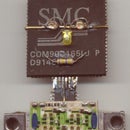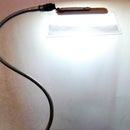Introduction: USB Li-ion Battery Charger
This is a charger for lithium ion batteries which takes its power from the USB port of a computer.
It uses the MCP73861 or MCP73863 Li-ion battery charger chip manufactured by Microchip.
It uses the MCP73861 or MCP73863 Li-ion battery charger chip manufactured by Microchip.
Step 1: The USB Power Connector
A piece of edge connector hacked off an ancient ethernet board serves as the power connector. To make it, cut off a piece that includes four edge fingers, and then file to make it fit inside the USB connector on the PC.
Step 2: The Circuit Board
The circuit board is a piece of single sided copper clad board. A hole is cut inside it so that it will accommodate the integrated circuit.
The MCP73861 or MCP73863 (they are similiar, with only slight differences which do not affect the circuit connections) is available in a small leadless package.
The difficulty? There are no leads to solder to. The advantage? There are no leads to break!
The ic is placed so that its connection side (the side with solder pads) lines up with the copper side of the board and it is then fixed in position with epoxy or some such glue.
The MCP73861 or MCP73863 (they are similiar, with only slight differences which do not affect the circuit connections) is available in a small leadless package.
The difficulty? There are no leads to solder to. The advantage? There are no leads to break!
The ic is placed so that its connection side (the side with solder pads) lines up with the copper side of the board and it is then fixed in position with epoxy or some such glue.
Step 3: Soldering the Integrated Circuit
The area around the ic is tinned and the solder pads joined to the board with bits of wire.
I find it helpful to flatten the wire with pliers before soldering, so that it stays in position without any tendency to roll about. Some of the leads go to the same node and these are conveniently placed together.
After the leads have all been soldered, the space in between the leads are cut out to form islands and the other components are soldered to these islands of copper.
I find it helpful to flatten the wire with pliers before soldering, so that it stays in position without any tendency to roll about. Some of the leads go to the same node and these are conveniently placed together.
After the leads have all been soldered, the space in between the leads are cut out to form islands and the other components are soldered to these islands of copper.
Step 4: Soldering the Components
The various components, as detailed in the data sheet for the ic (available from the web site of Microchip Technology) was then soldered in position. The two LEDs are new. All the other components have been rescued from old hard disks.
The red led is supposed to light up to inform us about error conditions. The other green LED (the clear one in the picture) lights up to indicate that charging is taking place. At the end of charging, it will blink or go out, depending upon the last digit of the ic part number.
The board is complete, all that remains is for it to be connected to the battery and the charging source.
If the source voltage is much above 5V a heat sink might have to be soldered to the thermal pad of the chip for charging to take place without interruptions due to the chip overheating.
It has integral thermal overload protection. If needed, a thermistor in contact with the battery may be used to protect the battery as well. The battery overheat protection feature has not been included in my version of the circuit.
The red led is supposed to light up to inform us about error conditions. The other green LED (the clear one in the picture) lights up to indicate that charging is taking place. At the end of charging, it will blink or go out, depending upon the last digit of the ic part number.
The board is complete, all that remains is for it to be connected to the battery and the charging source.
If the source voltage is much above 5V a heat sink might have to be soldered to the thermal pad of the chip for charging to take place without interruptions due to the chip overheating.
It has integral thermal overload protection. If needed, a thermistor in contact with the battery may be used to protect the battery as well. The battery overheat protection feature has not been included in my version of the circuit.
Step 5: The USB Connection
It is attached to the USB plug so that it can be plugged as a unit into the USB port of a computer, and the battery connected with wires. With a supply voltage of 5V and a maximum current of 500mA, overheating of the chip is not likely to be a problem.
Step 6: The Charger at Work
The charger is shown attempting to charge a mobile phone battery.
Li-ion batteries come in various flavours - single cell, double cell, coke anode, graphite anode etc. Each has to be charged to a specific voltage. Too low voltage leads to undercharging, with the result that the full capacity of the battery is not utilised.
Over charging the battery, even by as little as 0.1V, can lead to "spontaneous disassembly" of the battery, according to one manufacturer. That means it can explode, and catch fire, and potentially cause personal injury.
Use this circuit at your own risk.
The datasheets of the chip give information on configuring the chip to cope with different types of battery, and is an essential document in using the chip.
Li-ion batteries come in various flavours - single cell, double cell, coke anode, graphite anode etc. Each has to be charged to a specific voltage. Too low voltage leads to undercharging, with the result that the full capacity of the battery is not utilised.
Over charging the battery, even by as little as 0.1V, can lead to "spontaneous disassembly" of the battery, according to one manufacturer. That means it can explode, and catch fire, and potentially cause personal injury.
Use this circuit at your own risk.
The datasheets of the chip give information on configuring the chip to cope with different types of battery, and is an essential document in using the chip.





